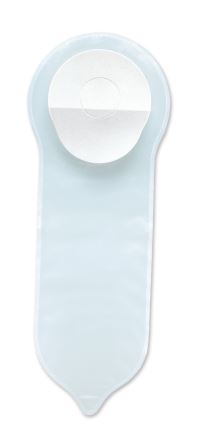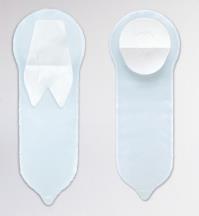URINE COLLECTION BAG, CHILD, closed, adhesive, sterile, boy
Valid Article
URINE COLLECTION BAG, pediatric, adhesive, closed ended
Definition
A sterile, flexible plastic pouch with an adhesive flange (typically with a gender-specific shape) intended to be attached to the skin around the genitalia to collect urine from an infant/paediatric patient. It is not designed with an opening for urine drainage and is typically used for biochemical, cytological and/or bacteriological sampling. This is a single-use device.
Specifications
Paediatric sterile adhesive bag for urine collection.
Technical specifications
- pouch = transparant plastic (PVC, PE, ..) for permanent visual control of urine.
- surface adhesive with zinc oxide (latex free)
- adhesive flange with a gender-specific shape
- closed bag: is not designed with an opening for urine drainage
- content: 100 ml
- suitable for children > 2.5 kg
- sterile, for single use
Packaging & Labelling
Packed in individual peelable blisters (1 peelable paper side with legal information, 1 transparent side) and are sold in boxes of either 20, 50 or 100 units.
Instructions for use
- Wash your hands very carefully.
- Place the child on its back.
- Carefully clean the skin with water and neutral soap. Antiseptic can be used on medical prescription only. The skin should be clean, dry, left ungreased and unpowdered. The skin must be free from irritation.
- Remove and discard central panel of the adhesive.
- Carefully and gently remove the release paper of the adhesive.
- Apply the pouch around the baby's penis or vulva with gentle pressure to ensure all edges are well sealed.
- To remove, gently lift one corner and peel off.
- To protect specimen, seal edges immediately upon removal, and if necessary add further strip of adhesive tape.
Precautions for Use
Make sure that the size of the pouch is adapted to the weight of the child
Within the context of biochemical, cytological and bacteriological examinations, the pouch should not be applied for more than 30 minutes avoiding by this way any risk of urine contamination (false positive). Even if the pouch is empty, you should replace it.
Send the urine to the analysis laboratory within 2 hours of collection. If this is impossible the specimen may be kept in a fridge for a maximum of 12 hours. Indicate the collection time on pouch.




